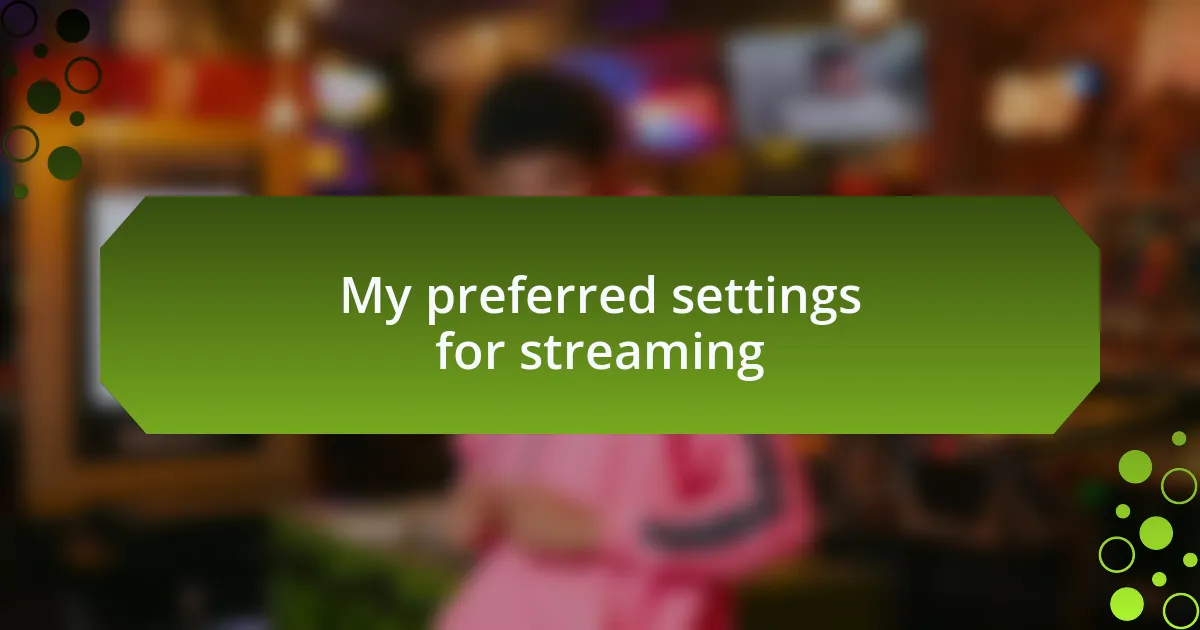Key takeaways:
- Streaming quality heavily depends on internet speed, resolution, and device capability, with a recommended speed of at least 25 Mbps for HD streaming.
- Compression technology plays a role in balancing data use and picture quality, affecting the overall viewing experience.
- Choosing the right streaming service involves assessing content variety, user interface, and device compatibility to enhance enjoyment.
- Adjusting playback settings, such as resolution and enabling adaptive bitrate streaming, can optimize the experience when facing fluctuating internet conditions.

Understanding streaming quality
Streaming quality can significantly affect your viewing experience, and it’s something I’ve come to appreciate deeply over countless binge-watching sessions. Picture this: you’re all set to watch a much-anticipated movie, but instead of crisp images, you get pixelated scenes. It’s frustrating, right? Understanding streaming quality means recognizing factors like resolution, bitrate, and your internet connection’s reliability.
When I first dipped my toes into streaming, I didn’t realize how much my internet speed impacted what I was watching. I remember eagerly tuning into a popular series that my friends raved about, only to be met with constant buffering. This made me wonder; why does streaming quality matter so much? High definition offers clarity and depth, while low quality can leave you feeling disconnected from the content.
It’s also worth noting the role of compression technology in streaming. While it helps reduce the amount of data transmitted, it can sometimes compromise picture quality. I’ve found that some platforms balance this beautifully—providing a rich visual experience without overwhelming my internet bandwidth. Isn’t it amazing how a better understanding of these factors can enhance our enjoyment of films and shows?

Factors influencing streaming quality
Many elements contribute to streaming quality, and one of the biggest players is your internet speed. I recall a time when I upgraded my plan, and the transformation was incredible. Suddenly, movies loaded almost instantly, and I could enjoy them without interruptions. It’s fascinating to think about how a simple upgrade can change your entire viewing experience.
Another crucial factor is the resolution the platform offers. I remember the first time I watched a film in 4K; it felt like I was stepping into another world. The detail was so vivid that it transformed scenes I’d seen countless times into something entirely new. So, when choosing a streaming service, it’s vital to check what resolution they support, as it can make or break your immersion.
Lastly, let’s not overlook the device’s capability to handle streaming. I once tried watching a new release on an older tablet, and I was met with choppy playback and distorted images. It made me realize that the device you use plays a massive role in the quality you experience. Have you had similar moments where your gear affected your enjoyment of a film? I know I have, and it truly highlights the importance of having the right setup for streaming.

Importance of internet speed
When it comes to internet speed, I can’t help but remember my frustration with buffering during an epic movie night. It seemed like every time the plot thickened, the video would freeze, forcing me to wait while my excitement dwindled. This experience solidified my belief that a reliable, fast connection can truly make or break the immersive experience of streaming.
I’ve also noticed that the difference between standard and higher-speed internet isn’t just about avoiding interruptions; it’s about overall quality. For instance, I once streamed a highly-anticipated film during a peak usage time. Although my connection is generally solid, that night it felt like I was back in the stone age of dial-up. The streaming quality dropped significantly, and it was a stark reminder of how dependent we are on our internet speed for seamless entertainment.
In my experience, a good rule of thumb is to aim for at least 25 Mbps for HD streaming, which might seem daunting but is attainable with the right plan. I’ve seen friends who skimp on speed only to regret it later when they miss out on a cinematic masterpiece. Isn’t it worth investing a little more in speed for an uninterrupted movie marathon? Trust me, the benefits far outweigh the costs when you’re curled up with popcorn, fully engaged in the story unfolding on screen.

Choosing the right streaming service
Choosing the right streaming service can feel overwhelming with so many options available today. I remember scouring the internet for the best service that could offer both variety and quality. It turned out to be a bit of a journey because I wanted not only the latest releases but also the classics I loved. Are you searching for nostalgia or the newest blockbuster? Identifying your priorities can help you narrow down the choices.
It’s essential to think about what each service brings to the table. For example, I once switched to a service that advertised a vast library, only to discover its interface was clunky and difficult to navigate. After a few frustrating evenings, I switched back to my old service—one that might have fewer titles but offered a smoother experience. Isn’t it interesting how sometimes less can be more?
Lastly, consider the device compatibility of the streaming service you’re eyeing. I’ve had moments where I was excited to dive into a new series, only to find out that it wasn’t supported on my device. That was a real buzzkill! Being able to stream seamlessly on the devices you already own makes the whole experience much more enjoyable. Have you checked how well the service fits into your current setup?

My preferred settings for streaming
When it comes to my preferred settings for streaming, I usually opt for a resolution of 1080p. This strikes a nice balance between quality and bandwidth usage. I remember upgrading to 4K once, thinking it would enhance my viewing experience, but the buffering issues were a real headache. Have you ever been excited to watch something, only to be met with constant interruptions?
In addition to resolution, I always adjust my streaming service’s playback settings to allow for adaptive bitrate streaming. This feature automatically adjusts the video quality based on my internet speed. I’ve found it minimizes interruptions when my Wi-Fi fluctuates—like that one evening when my neighbors decided to throw a party right as I was getting into a gripping scene. It’s such a relief to know the streaming service can handle these hiccups without ruining the moment.
I also make sure to turn on subtitles whenever I’m streaming. This tiny adjustment makes a huge difference, especially with dialogue-heavy films. I recall zoning out during a dramatic scene because I couldn’t catch every word. Now, I appreciate not missing any nuances of the story. Do you find subtitles enhance your viewing too?

Tips for optimizing streaming quality
To optimize streaming quality, I always consider my internet speed before diving into a movie. A few months back, I realized my connection could be a bit slow at peak hours, so I decided to run a speed test during those times. I found that keeping my speed above 25 Mbps ensures a smooth experience, sparing me from those frustrating buffering moments. Have you ever wondered if your internet is fast enough for that binge-watch session?
Another crucial tip is to connect directly to my router with an Ethernet cable whenever possible. I made the switch one night when I noticed my Wi-Fi signal was weak, and it was an absolute game-changer. The difference in streaming quality was remarkable. It’s like swapping out your old TV for a state-of-the-art model—suddenly, everything looks clearer and runs seamlessly.
Lastly, I regularly clear my streaming apps’ caches. It might sound technical, but I used to overlook this simple task until I noticed my favorite streaming service was lagging more than usual. After clearing the cache, it felt like I had a fresh start, and all those pesky glitches disappeared. Have you ever tried cleaning up your streaming apps? It could make a world of difference!

Personal experiences with streaming quality
In my journey with streaming, I’ve often found that the time of day seriously impacts quality. I remember one Friday evening, eagerly settling in for what I thought would be a relaxing movie night. Just as the opening credits began to roll, the screen froze—and not just for a second. I had a sinking feeling in my stomach as I realized my household was competing for bandwidth. Have you had those moments where your plans are derailed by a simple internet hiccup?
On another occasion, I experimented with adjusting playback settings. I used to think higher resolution always meant better quality. Then, during a thrilling action sequence, my heart sank as the video stuttered. I discovered that sometimes, opting for a lower resolution when my connection isn’t great makes for a much smoother experience. It taught me that patience and flexibility in settings can make all the difference.
I can’t forget the time I was engrossed in a documentary, and the audio unexpectedly desynced from the video. This was particularly frustrating because the content was so captivating! After some troubleshooting, I learned that updating my streaming device’s software can often resolve these annoying glitches. It’s a simple fix, yet one I had previously overlooked. Have you ever felt that pain of watching something you love but being brought back to reality by technical issues?